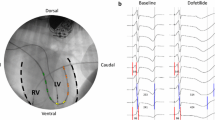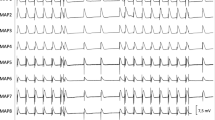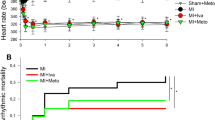Abstract
The clinical use of positive inotropic agents has been associated with increased mortality, with proarrhythmia speculated to be a contributing factor. This study compares the arrhythmogenic potential of six positive inotropic agents representing different mechanistic classes: the β-adrenergic agonist dobutamine, the adenylyl cyclase activator forskolin, the phosphodiesterase-III inhibitor milrinone, the cardiac glycoside ouabain, and the sodium channel agonists DPI 201-106 and BDF 9148. These agents were studied in dogs with anterior myocardial infarction using lower and higher dose i. v. regimens targeted to elicit 20–40% and 70–90% increases in LV+dP/dt, respectively. Precipitation of new ventricular arrhythmia by programmed ventricular stimulation was observed in all treatment groups. Incidences of new arrhythmia were comparable in the lower dose regimens, ranging from 16.7% (3/18 animals with BDF 9148) to 31.6% (6/19 animals with DPI 201-106), and in the higher dose regimens, ranging from 10.0% (1/10 animals with milrinone) to 27.7% (5/18 animals with DPI 201-106). The overall incidence of new ventricular arrhythmia ranged from 27.3% (3/11 animals with ouabain) to 47.4% (9/19 animals with DPI 201-106). No differences were observed in underlying infarct size or time from infarction to electrophysiologic study between subgroups of animals in which new arrhythmias were precipitated vs. those remaining non-responsive in any treatment group. The positive inotropic agents tested displayed diverse total group effects on heart rate, electrocardiographic intervals including QTc and ventricular refractoriness. Within individual treatment comparisons revealed a general but not universal pattern of greater ventricular refractory period values in newly inducible vs. non-inducible subgroups in the DPI 201-106, BDF 9148 and ouabain (low and high dose); milrinone and dobutamine (high dose) treatment groups. These findings indicate that regardless of underlying cellular mechanisms of action, the six positive inotropic agents tested all displayed comparable proarrhythmic potentials unrelated to underlying infarct size and time from infarction. This observation suggests the general shared property of increased myocardial contractility, potentially adversely affecting myocardial oxygen balance, myocardial perfusion and electrical stability in the setting of previous myocardial infarction, to be a common underlying cause for arrhythmogenesis. Additionally, alterations in ventricular refractoriness and repolarization may contribute significantly to proarrhythmia with some positive inotropic interventions.
Similar content being viewed by others
Author information
Authors and Affiliations
Additional information
Received: 20 July 1999, Returned for 1. revision: 16 September 1999, 1. Revision received: 26 October 1999, Returned for 2. revision: 24 November 1999, 2. Revision received: 22 December 1999, Accepted: 6 January 2000
Rights and permissions
About this article
Cite this article
Stump, G., Wallace, A., Gilberto, D. et al. Arrhythmogenic potential of positive inotropic agents. Basic Res Cardiol 95, 186–198 (2000). https://doi.org/10.1007/s003950050181
Issue Date:
DOI: https://doi.org/10.1007/s003950050181




